Culture of Venezuela
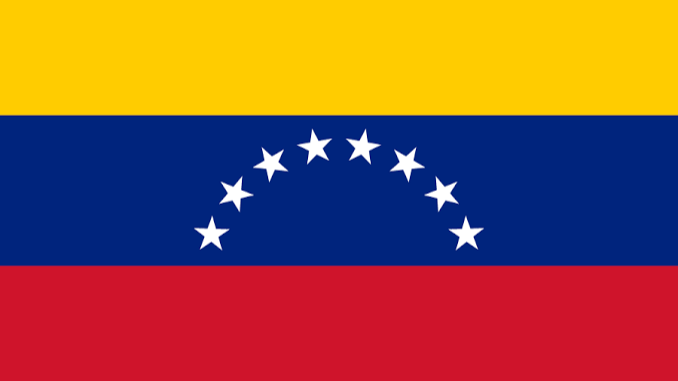
Culture Name
Venezuelan
Orientation
Identification. In 1499, as a member of Christopher Columbus's third voyage to the Americas, Alonso de Ojeda made an initial reconnaissance of what is today Venezuela's northern Caribbean coast. Ojeda named this region Venice because the indigenous houses were located on stilts above the Orinico River's current. This initial name later evolved into that of Venezuela, which was then used to name the colonial territory under Spanish rule as the Capitanía General de Venezuela.
Venezuela's national population is very similar to that of most other South American countries, with a mixture of an initial indigenous population, a large Spanish influx, and a significant population of African ancestry. There have also been notable European and Latin American migrations in the last two centuries. Even with these different populations, however, Venezuela has one of the most stable national identities in the continent. This national stability is probably due to two factors: (1) Venezuela has an extremely small contemporary presence of indigenous communities to contest the national stability, and (2) until the 1990s Venezuela boasted an incredibly strong national economy.
Location and Geography. Venezuela is located on the northern (Caribbean) coast of South America. It has an area of 352,144 square miles (912,050 square kilometers) and is bordered by Guyana to the east, Brazil to the south, Colombia to the west, and the Atlantic Ocean and Caribbean Sea to the north. In general, Venezuela is usually divided into four major environmental regions: the coastal zone, the Andean mountain range, the llanos (plains), and the Guiana Highlands.
Venezuela's capital, Caracas, and all the other major cities are located along the coast. Historically the coast has been the most populated area in the country and is where most of Venezuela's population lives today. The rest of the country is traditionally referred to as the interior ( el interior ). The northernmost tip of the Andes' continental range runs through the northernmost part of Venezuela. Andean inhabitants are portrayed as conservative and reserved, having more in common culturally with other Andean populations than with the rest of the country.
The llanos is by far the largest region in the country, making up one-third of the territory. The region is mainly great open plains with small foothills toward the north, dividing the region into low and high llanos. The population in the region is typically portrayed as open and rugged plains-people. The population is far from homogenous, however, and even the language spoken in the region still reflects both indigenous and African linguistic influence.
To the east the llanos end at the Macizo Guayanés (Guyanese Mount) which is one of the oldest rock formations in the world. The region to the south, the Guiana, is also referred to as La Gran Sabana (Great Savanna) since it is composed of savannas and flat mountaintops (referred to as tepuis in the indigenous Pemón tongue). It was this environment that Sir Arthur Conan Doyle (1859–1930) immortalized in his epic, The Lost World. Further south is the Amazonas with its hot and humid tropical forest. The Amazonas region is sparsely populated even though it includes 70 percent of Venezuela's indigenous population.
Demography. Venezuela is mainly made up of four groups: mestizos, or pardos, (mixed European and Indian ancestry), comprising 67 percent of the population; white (European descent, mainly Spanish, Italian, and Portuguese), 2l percent; black (African and Caribbean descent), 10 percent; and Indian (Native Americans), 2 percent. These groups tend to be regionally localized: The cities are mainly (but
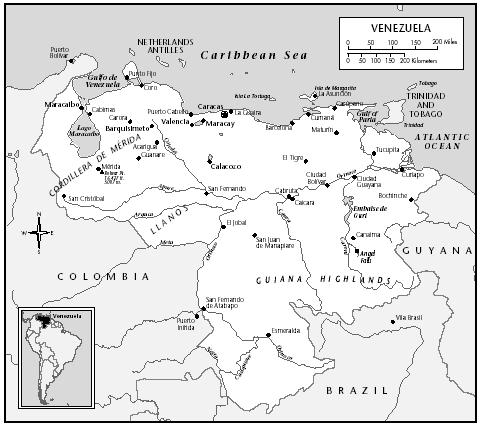
Venezuela
not exclusively) inhabited by whites and pardos; Indians occupy the remote Guianan and Amazonas interior; and blacks live along the Caribbean coastline. At least one-fourth of Venezuela's contemporary population consists of immigrants, many of them illegal.
Linguistic Affiliation. Venezuela's official language, Spanish, was introduced into the territory in the sixteenth century. There are still twenty-five surviving indigenous languages belonging to three linguistic families: Caribans, Arawak, and Chibcha. A strong African linguistic presence is also felt along the coastal region. It is English, however, that is slowly becoming the country's second official language. As extremely modern-minded citizens, Venezuelans feel it is necessary to be fluent in English for cultural and commercial purposes. Venezuela's oil boom has also contributed to an increase in English usage, and many private schools use English in a bilingual curriculum.
Symbolism. The most cohesive national symbol is the image of the country's main independence fighter, General Simón Bolívar (1783–1830). Bolívar led the military movement that freed Venezuela and the neighboring countries of Colombia, Ecuador, Peru, and Bolivia of Spanish domination. Statues of him are present in almost every city and town, and the country's currency and the main airport (as well as many other institutions) are named after him.
Venezuelans are also one of the most appearance-minded people in the world. Venezuelans place an extreme national pride on their physical beauty, fashion, and overall outward appearance. They also express pride in the fact that Venezuelan contestants either win or place very well in the yearly Miss World and Miss Universe beauty pageants. Although beauty is predominantly a concern for the female population, males have also increased their awareness of beauty standards, and a yearly male beauty pageant has also been instituted. This beauty concern is also reflected in the growth of the television media in the country. Venezuela was one of the first exporters of telenovelas (soap operas) to the South American continent and the world.
Another national symbolic marker is the Caribbean coast along with its grand Lake Maracaibo. Lake Maracaibo itself is approximately 130 miles (209 kilometers) long and 75 miles (120 kilometers) at its widest, and is directly connected by a narrow strait to the Caribbean Sea. The coastline and lake reflect the symbiotic relationship of the country with both South America and the Caribbean. The Caribbean coastline, and its imagery of sand, sun, and pleasurable delights, also supports the second largest industry of the country, tourism.
History and Ethnic Relations
Emergence of the Nation. The current Venezuelan nation as such appeared in 1829. Venezuela had three brief republican configurations before 1829. The first Venezuelan republic was a short-lived rule forged in 1810 by Venezuela's Francisco de Miranda; Miranda surrendered to the Spaniards in 1812 and died in exile in 1816. The second republican junta (1813) was led by Simón Bolívar himself but was as short-lived as the initial republic. Finally, Bolívar was able to oust the Spanish colonial empire in the Battle of Carabobo on 24 June 1821, and proclaimed Venezuela part of the Republic of Gran Colombia (which included the contemporary states of Colombia and Ecuador). Because of internal political conflicts and Bolívar's waning health, however, Venezuela proclaimed itself an independent republic on 5 July 1829.
National Identity. Venezuela has been able to sustain a national identity that owes much to its Spanish colonial heritage. The country has maintained a white (European) national ethos and its top positions have typically been secured for its lighter-skinned citizens. This European-minded identity has been very much part of Venezuela since its initial republican origin. For example, in many of Bolívar's foundational writings the Indians, pardos, and blacks are referred to in paternalistic fashion and benevolently advised to come into the modern civilized fold. This particular national ethos, however, has not gone unaffected by both the pardo and black communities, which together make up more than two-thirds of Venezuela's population. This demographic reality in itself is reflected in Caribbean and Latin American cultural characteristics even in the face of a white ideology central to the national identity.
Ethnic Relations. The four main cultural groups are very much regionally oriented: whites and pardos are mostly city dwellers; Indians live in the Amazon as region; and blacks along the Caribbean coast. These groups have maintained a surprisingly small amount of modern ethnic friction considering the predominantly white control of the country. This Europanist trend has also significantly impacted Venezuela's large immigrant population.
In the 1840s and again during the early 1900s Venezuela consistently attempted to entice Europeans to migrate to the country. Both of these campaigns proved unsuccessful, with Spanish, Italian and Portuguese immigrants flocking to Venezuela only after World War II. These constant attempts to bring in skilled workers and to "whiten" the national population were further supported by congressional proposals in the late 1800s to prohibit the immigration of Asians and black.
By far the largest immigrant group in the country, however, is Colombians, followed very closely by other South Americans—Ecuadorians and Chileans—and Caribbeans, mainly Dominicans and people from the Lesser Antilles. Since the 1960s, largely due to the oil boom, official immigrant restrictions on nonwhite populations have ended. By then, however, social power was solidly entrenched among the white elite.
Urbanism, Architecture, and the Use of Space
Venezuela's spatial landscape is clearly demarcated between the urban and the rural. The city of Caracas, with its 4 million inhabitants (almost a fifth of the country's total population) is the emblem of a modern elite and European-style existence. Meanwhile the rural homesteads of the llanos, Andes, and Guiana Highlands represent a farming way of life with a more traditional subsistence strategy. The recent influx of rural migrants (both from Venezuela and abroad) has impacted the urban landscape, especially within the ranchos (lower- and middle-income
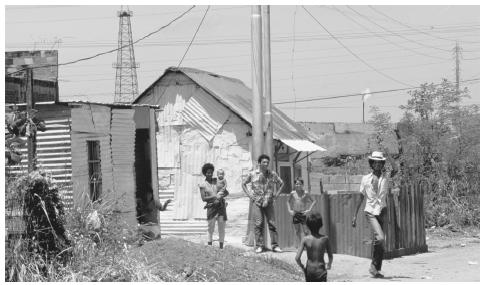
Simple homes with a flaring oil well in the background, Cabimas. Oil is Venezuela's most profitable export product.
urban housing). Modern ideals and the escalating Americanization of Venezuelan culture have increasingly diminished the presence of traditional rural customs in the city centers.
This blend of modernist aspirations tempered with local traditions, including colonial architectural remnants, has created a unique Venezuelan style. A particular architectural expression of this is the internationally acclaimed construction of the Central University of Caracas, designed by the Venezuelan architect Carlos Raúl Villanueva, with asymmetrical buildings, large standing murals, and sculptures.
Food and Economy
Food in Daily Life. Venezuelans have three main meals: a large breakfast, a large dinner (around noontime), and a very light supper in the evening. Venezuelan hospitality is widespread, so something to drink and eat is expected when visiting someone's home. Arepas, the most distinctive Venezuelan food, are thick disks made of precooked cornmeal, either fried or baked. Large arepas, with a variety of fillings (ham and cheese is the most popular one), are eaten as snacks throughout the day; smaller arepas are typically served as side companions at all meals.
Similar to arepas are empanadas (deep-fried pasties) and cachapas (a pancake/crepe-like dish), which are filled with cheese, ham, and/or bacon. Among the other main Venezuelan dishes are the pabellón criollo, which consists of black beans, fried sweet plantains, white rice, and semi-shredded meat ( carne mechada ), all topped with a fried egg. Also popular are pernil (roasted pork), asado (roasted beef), bistec a caballo (steak with fried egg), and pork chops. Fruit juices are also extremely popular and there is also a great variety of salads, although these are traditionally seen as a complementary, not a main, dish.
Tequeños, long small rolls filled with hot cheese or chocolate, take their name from Los Teques, a city just outside Caracas. The typical drink of the llanos, chicha, is made out of ground rice, salt, condensed milk, sugar, vanilla, and ice.
Basic Economy. That Venezuela was until 1970 the largest oil exporter in the world positively differentiated its economy from other South American nations. Since the 1940s oil revenues were consistently used to diversify Venezuela's national industry. This national trend has most significantly affected a strong mineral export policy and the development of hydroelectric energy. It was only in the mid-1970s that Venezuela was finally able to break the multinational hold over its oil and gas industry. This transnational privatization trend returned in the 1990s, however, when a drop in oil prices, global recession, inflation, unemployment, government corruption, and a lack of skilled personnel forced the reversal of the initial nationalizing policy. An increasing foreign debt as well as large level of illegal immigration further burdened Venezuela's troubled economy at the turn of the millennium. Venezuela has responded to these circumstances with growing support and continued diversification of its industry, larger agricultural outputs, and greater exploitation of its natural resources.
Land Tenure and Property. Until the 1950s and 1960s when the first agrarian reform projects were implemented, the land distribution was still very similar to that of colonial days, allowing 2 percent of the population to control over 80 percent of the land. Agricultural production is also quite underdeveloped with less than 5 percent of the total territory dedicated to farming. There is still a large group of traditional farmers harvesting small family plots ( conucos ), with their main crops being corn, rice, coffee, and cacao. Large agricultural producers ( fincas comercializadas ) have most significantly benefitted from government and state funding, allowing them to use large amounts of wage labor, fertilizers, and insecticides, and to also mechanize their production. There are also large herding farms ( fincas ganaderas ), some over 6,000 acres (2,430 hectares), located in the vast llanos region.
Major Industries. More than half of Venezuela's labor force is incorporated into the service sector of the economy, while less than 40 percent of the population is dedicated either to agricultural or industrial production. Venezuela has quite a diversified industrial sector, largely due to its reinvestment of oil resources. The first type of industry are the oil refineries and petrochemical plants themselves. These tend to be located around Puerto Cabello (just west of Caracas) and in the state of Zulia (Venezuela's westernmost state). The second largest industry is the production of consumer goods. Import substitution strategies have been established for goods such as textiles, leather, paper, tires, tobacco, light engineering products, and modern appliances. The auto industry has also attempted, albeit less successfully, to establish its own assembly industry. The third type of industry is the production of heavy industrial materials such as iron, steel, and aluminum.
Trade. Venezuela's most lucrative export item is oil. Its main trading partner is the United States, with which it has been able to maintain favorable trade balances. Venezuela imports machinery, transportation equipment, pharmaceuticals, food products, tobacco, and beverages from the United States in exchange for its oil. Venezuela's other major trading partners are the Netherlands, Japan, Germany, France, Italy, Brazil, and Colombia.
Division of Labor. The main division of labor in the country is between rural and urban populations. By far, rural occupations such as agriculture and cattle herding are considered to be less sophisticated. This same modernist ideal contributes to a division between manual and specialized forms of labor. The immigrant population occupies most of the menial and less remunerative forms of employment which Venezuelans themselves avoid. In the 1990s, however, there was a significant lack of local specialized workers; this was one of the main factors that seriously compromised the country's oil production.
Social Stratification
Classes and Castes. Venezuela does not recognize an official caste system although it does participate in a strongly defined class structure that is not without its strong caste implications. The class system places most of the political and economic power in the hands of a very small group (less than 10 percent of the population). The elite is composed of the traditional white population; this also provides white (European) immigrants greater opportunity for participating in Venezuela's economic wealth. Meanwhile this color/racial division is most dramatically felt by Latin American immigrants of African and Indian ancestry, who are forced to form the lowest ranks of Venezuelan society.
Venezuela also developed a large middle class in the twentieth century mainly as a result of the oil revenues. The middle class, and in particular the large lower-middle class, was significantly affected by the social crisis of the 1990s which led to large-scale riots that caused thousand of deaths and the collapse of President Carlos Andrés Perez's government.
Symbols of Social Stratification. Media images of physical beauty and fashion are the most salient symbols of social stratification. How one looks, what one wears, one's profession, and one's wealth are the greatest markers of social status. The country's preoccupation with a modern beauty ideal and personal hygiene is closely related to a colonial complex of idealizing European (white) culture. Since
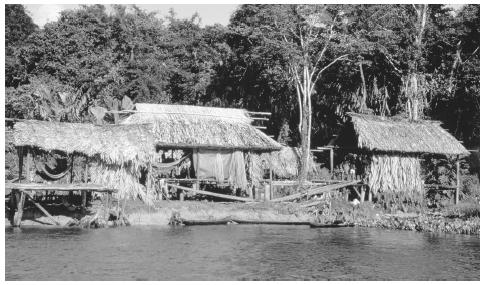
Thatched huts along the shore of a river. This type of dwelling is home to the indigenous peoples of Venezuela.
World War II, U.S. pop culture has most significantly attracted and been imitated by Venezuelans. The reification and embodiment of North American ideals of beauty, musical genres, and fashion define who maintains the greatest level of social status.
Political Life
Government. Venezuela's government is federalist in nature, composed of executive, legislative, and judicial branches. The executive branch is led by a popularly elected president who holds office for five years. The legislative branch is composed of a Congress that is divided into a Senate and a Chamber of Deputies. The Chamber of Deputies reflects the country's regional representation, while the Senate has two representatives from each state and the capital's federal district. Venezuela's highest judicial institution is that of the Supreme Court, whose members are elected by the representatives of Congress.
Leadership and Political Officials. In 1999 Colonel Hugo Chávez Frías was overwhelmingly voted into office as Venezuela's president. Chávez's election as president was striking because he had recently been imprisoned for leading a failed coup against the government of Carlos Andrés Pérez. But Chávez can best be described as a caudillo (popular leader), that is, a leader who expresses an idiosyncratic nature and has wide-level popular support. In fact, until 1935 Venezuela had mainly been lead by strong military caudillos. It was not until 1969 that the first transition between two popularly elected democratic governments occurred.
The two main political parties are the Social Christian (COPEI) and the left-leaning Democratic Action (Acción Democrática), although the left-leaning MAS (Movimiento al Socialismo) and Radical Cause (Causa Radical) also have popular followings. Nevertheless, the fragile political party structure is still evident in the election of strong caudillo figures such as Chávez and in his explicit effort to try to dismantle the political party system.
Social Problems and Control. The largest problems in terms of social unrest are those that result from traditional crimes and riots. Crimes come in all shapes and sizes, from petty theft to widespread government corruption. Most street crime is committed at night or in the poorest neighborhoods of the urban centers. These violent crimes, although committed at gun- or knifepoint, tend to be fatal less often than they could be. There is, however, widespread carrying of guns not only by the police but also by private guards and a significant part of the male population. All of this contributes to constant shoot-outs and police chases, which produce a notable increase in wounds and death. At the same time the police and other government officials do not tend to garner much public affection, which only increases the difficulty of maintaining the public order. In the 1990s the economic crises also contributed to traditional forms of public protests and riots. This unfortunately had its climax during Pérez's government when confrontations between the people and the army and police led to over a thousand deaths.
Military Activity. The Venezuelan military includes an estimated eighty thousand members divided into the navy, army, and air force. The country has traditionally maintained low levels of defense expenditures, averaging only 1.5 percent of its gross domestic product. Venezuela has had ongoing historic conflicts with neighboring Colombia and Guyana, which flared up in the 1980s. Since then, however, the military has been less concerned with international conflicts than with maintaining internal political order. The military has also been brought in to investigate cases of ransom kidnaping, which have significantly increased since the 1980s.
Nongovernmental Organizations and Other Associations
In striking comparison to most other South American countries, Venezuela has a negligible presence of nongovernmental organizations. The two areas that most vividly benefit from international and local support are the environment and human rights advocacy. The area around Lake Maracaibo and the Amazon regions are the ones most generally presented as in need of local legislative protection. Meanwhile, it is also Amazon indigenous groups such as the Yanomamo who receive the greatest amount of international funds to defend themselves against government and private mining incursions in their territory. Unfortunately the Yanomamo have been the target of genocidal massacres as well as the constant threat of the destruction of their traditional ways of life.
Gender Role and Status
Division of Labor by Gender. Men overwhelmingly occupy the most important political, economic, social, and religious positions in Venezuela. The traditional sexist Western gender division of labor is present in Venezuela, with men occupying the most physical demanding jobs while women are
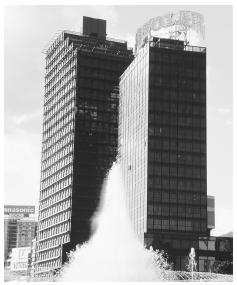
Skyscrapers and a fountain in Plaza Venezuela, Caracas, exemplify the ideals of modernization and Americanization.
traditionally relegated to household or domestic service jobs. In the rural areas, however, women and men both partake in demanding physical labor, and Western roles are somewhat blurred. Cattle herding, however, is still a predominantly male occupation. Meanwhile, the beauty pageant industry and the preparation of females for international competitions seems to both sustain and subvert traditional Western notions of female and male occupations. In this manner females are still highly regarded as beauty objects but more and more men are also raised to similar standards of sexual objectification.
The Relative Status of Women and Men. Venezuela is a very patriarchal society expressing its own distinct national brand of machismo. Although men and women are legally equal, there are still great differences in terms of actual wage earnings, sexual freedom, and social expectations. In daily life, men are still expected to work outside the home, support the household, and prove their virility with many heterosexual liaisons. The modernist trend of following North American culture, however, is creating conflicts with these traditional gender expectations. Women are more and more a part of the general workforce, increasing their economic standing and discarding the exclusive domestic burden of the household and child rearing.
Marriage, Family and Kinship
Marriage. Venezuelans practice open-ended marriages, meaning there are few legal restrictions as long as the person marries someone of the opposite sex and of legal age. In actuality, however, there are several concerns regarding whom one should get involved with, particularly in terms of class and racial distinctions. It is expected and predominant that people marry others of their same or higher social class standing—including racial status as well. The ideal is generally to marry somebody "whiter" or at least of the same racial status; the opposite, although not completely rare, is seen as going against the norm.
Domestic Unit. In Venezuelan society the family and the role played by the mother are essential in the maintenance of the social fabric. Most people tend to live in nuclear families (parents and siblings), although extended kin (grandparents, aunts, uncles, and cousins) traditionally live close by. When migration has produced a break in the family, the ties are closely maintained through letters, phone calls, and e-mail. In this manner it is not surprising that children (both male and female) live with their parents until their mid-twenties or until they marry and can move out on their own. It is expected that family members do everything in their power to help and support all family members—help that can range from getting each other jobs to making space for them in their own homes.
Inheritance. Inheritance rules are legally prescribed and there is no major distinction in terms of gender, class, or race. The higher status one holds, however, the more successful one is in maneuvering Venezuela's complex legal and social system.
Socialization
Child Rearing and Education. Children are traditionally cared for by their parents, although the extended kin may also play a major role in the upbringing. In terms of child rearing the national culture espouses Western ideals of good behavior, education, and competitiveness. On top of this an enormous amount of friendliness, generosity, and overall good nature is expected of children as they grow up.
Venezuela provides free and compulsory education through grade twelve for all its population. In 1995 literacy was estimated at over 90 percent. Private and Catholic schools provide a large array of grade and high schools ( liceos ) mainly in the major urban centers. These private institutions have far better reputations and are where most of the middle and upper classes send their children.
Higher Education. In general only 20-30 percent of Venezuela's population goes on to obtain a university degree. Since the 1950s there has been an increasing proliferation of private universities although by far the ones with the best reputations are public ones such as the Universidad Central de Caracas (the Central University in Caracas). A university degree or title (normally referred to as carrera ) traditionally takes between four and five years after which one obtains the degree of licenciado (equivalent to or higher than the bachelor of arts degree in the United States). There are a series of master's level graduate programs but doctorates at the Ph.D. level are quite rare.
Etiquette
Venezuelans are characterized by their outgoing and gregarious nature. This extroverted behavior is visible in the traditional forms of greeting and in people's body language. When meeting somebody, even if it is for the first time, it is common to give two kisses, one on each cheek; women greet men and women this way, while men only kiss women. Between men a strong-gripped handshake is the custom and many times this is accompanied by the placing of the other hand on the side for greater emphasis. A hug is also used between men, especially if the men have not seen each other for a while. These forms of male greeting, however, are used for people of equal status and indicate familiarity and therefore are not be used with somebody of higher status.
Body language between Venezuelans is also much more fluid and pervasive. People stand very close to each other while talking and will gesticulate with their hands and bodies to make a point. It is also common for people to touch each other to even further emphasize what it is that they are saying. Friendly conversations can also appear to be arguments because of their loud and freewheeling nature. Meanwhile there is also lots of unique sign language. For example, pointing with one's finger is considered rude and vulgar; it is much more acceptable and widely understood if one just points with one's mouth. At the same time a smaller version of the "okay" symbol is usually meant as an insult rather than as a symbol of agreement.
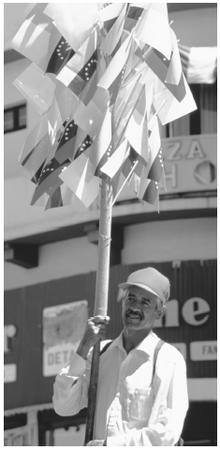
A peddler selling Venezuelan flags. Statues of freedom-fighter Simón Bolívar are pervasive throughout the country.
There is also an enormous amount of public expression of machismo. Women are customarily showered with remarks and gazes from men who want to display admiration and awe at their sexual beauty. This behavior, however, very rarely goes further than a piropo (small adulatory phrase) and any touching or pinching is not condoned. Women tend to ignore most of these remarks and from early on learn not to publicly acknowledge them (either favorably or not).
Religion
Religious Beliefs. Most Venezuelans—at least 90 percent of the population—are Catholic. Since the 1980s, Protestant religions have been attracting more followers, especially Evangelists and Adventists, and to a lesser degree, Mormons. There are also significant Jewish communities in Caracas and Maracaibo; these communities are traditionally grouped under the banners of the Asociación Israelita Venezolana (Israeli Venezuelan Association) and the Unión Israelita de Venezuela (United Israelis of Venezuela). Venezuela also has a smaller number of Islamic practitioners.
Most indigenous religious practices were lost with the decimation of the Native American population and the few surviving indigenous populations practice their religious traditions in complete isolation from the national culture. Even though indigenous religion did not survive intact, many Venezuelans participate in a symbiotic religious practice known as the culto of María Lonza ( culto meaning more religious practice than cult). This culto has its home base in the hill of Sorte, near the small town of Chivacoa, just east of the larger western city of Barquisimeto. María Lonza is portrayed as a Venezuelan witch/healer who was born from an Indian father and a Creole Spanish mother. She is traditionally represented with two other figures, that of a black henchman, el Negro Felipe, and of an Indian cacique (chief), Guaicapuro. The three of them together are traditionally referred to as the Three Powers ( Tres Poderes ).
Another interesting religious belief shared by Venezuelans is the veneration for the figure of Dr. José Gregorio Hernández. This Venezuelan doctor, who lived during the late 1800s, was recently given venerable status by the Vatican but is still not officially recognized as a saint by the church. Nevertheless, this has not deterred a widespread following in Venezuela (and other Latin American countries) that proclaims Brother Gregorio (as he is referred to) a miraculous healer who actually operates and heals people while they sleep.
Rituals, and Holy Places. The Catholicism practiced in Venezuela very much follows the guidelines of the Roman hierarchy. Masses are held everyday but attendance is obligatory only on Sunday. Since the Second Vatican Council masses are no longer said in Latin but in Spanish, and the priest (males only) now faces the public as opposed to celebrating the ritual with his back to them. The mass is believed to recreate Jesus' last supper with his apostles before his crucifixion, and the ritual itself is believed to transform bread and wine into the body and blood of Christ to be partaken of by everybody free of mortal sin. There are Catholic churches throughout Venezuela with the most impressive cathedrals located in Caracas and other major cities. In smaller towns, however, there are also churches with a grand colonial architectural style: these churches had greater importance during Venezuela's colonial period than they do now.
The principal rituals associated with the culto of María Lonza involve the main practitioners falling into trances through hypnotic music, dancing, rum drinking, and painting themselves with different color dyes. During these trances they "see" what is in the supplicant's psyche and what the future has in store for them. Even though this culto has a strong rural and Afro-indigenous origin it is not uncommon to see practitioners from all social backgrounds and classes involved. There is also a statue of a naked María Lonza riding on a tapir in the center of Caracas.
Death and the Afterlife. Venezuelans' belief in the afterlife follows the Roman Catholic belief in hell (for those who were evil in life), purgatory (for those who still need to do penance for their sins), and heaven (for those without any fault). Even the syncretic practices of María Lonza and San Gregorio are intertwined with this Catholic understanding of death and the afterworld. In the practices of Maria Lonza and San Gregorio, however, both also express the possibility of communicating with dead spirits and deities. These beliefs in establishing an actual connection with the world beyond death are closer to the beliefs of African-based religions such as voodoo than to those of Christianity.
Medicine and Health Care
Venezuela's health-care system has a large array of public and private hospitals and clinics. Even though the country's health coverage is better than that of most other South American countries, its public system is still far from exemplary. The public hospitals normally have long lines and waiting periods, and they tend to be understaffed (there is a particular shortage of nurses) with the staff they do have being overworked. Private clinics, however, are quite well operated, and the people who can afford to can get some of the best medical care in the world. Similar to other "developed" Western nations, most deaths in Venezuela are due to heart attacks, cancer, and fatal accidents. AIDS is also present but is still not a major epidemic as in the United States or certain African countries.
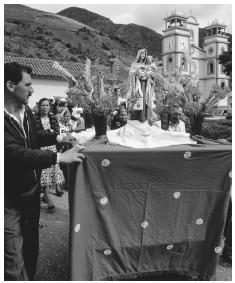
Parishioners push a portable shrine past a church during a festival. Most Venezuelans practice Catholicism.
In general the death rate is four for every thousand, while the birth rate is twenty-nine for every thousand. Most traditional tropical and third world diseases have been eradicated in Venezuela, although infant mortality is still much higher than in most European countries. Although Western medicine is the most popular mode of health care, other non-Western traditions are surprisingly still present. Surviving in many rural belief systems, herbal remedies (including rubbing the body with plants while saying certain prayers) are still widely believed to cure nontraditional ailments such as the evil eye and various emotional afflictions.
Secular Celebrations
There are several important and officially recognized holidays in Venezuela other than New Year's and Christmas. Carnival is by far one of the liveliest Venezuelan traditions. This holiday falls on the three days prior to Ash Wednesday (in the Catholic calendar). It normally means a holiday exodus from Caracas and other cities to Venezuela's Caribbean coast and even to Trinidad (an island off the northeast coast of Venezuela), which is famous for its Carnival celebrations. In the coastal towns Carnival means general partying with lots of drinking and dancing, parades with drummers and people in costumes, and a generally greater level of sexual undertones.
Other important holidays are Bolívar's birthday (24 July) and Venezuela's Independence Day, which is celebrated on the day of the victorious Battle of Carabobo (24 June). The Day of the Race (Día de la Raza) is celebrated on 12 October with parades. This day also holds great religious significance for María Lonza followers. Venezuela also celebrates a series of religious town festivals that commemorate either the appearance of the Virgin Mary (or of a saint) to an Indian/rural peasant or the miraculous protection of the town from an epidemic or natural disasters. The most famous of these festivals include: the Feast of Corpus Christi in San Francisco de Yare, the Feast of the Divina Pastora (the Divine Sheperdess) in Santa Rosa, and the Feast of San Juan Bautista (Saint John the Baptist), which is celebrated by extensive rhythmic drumming and dancing in Caracas and other parts of the country.
The Arts and Humanities
Support for the Arts. Since the 1920s the Venezuelan state has invested in developing and maintaining a national culture through the arts. The two areas that have most benefited from this support have been literature and music. Caracas features a publicly financed symphony orchestra that plays not only classical genres but also the more nationalistic genre of joropos. The state also supports several museums that house some of the national artistic production. The three prime ones are: the Museum of Fine Arts, which was founded in 1938; the Museum of Colonial Art, which is located in an eighteenth century house; and the Museum of Natural Sciences, which was founded in 1940 and houses over fifteen thousand exhibits. All three are located in Caracas.
Literature. Very few Venezuelan artists are known outside of the national borders. Exceptions to this in literature include the writers Rómulo Gallegos and Arturo Uslar Pietri. Gallegos in first part of the twentieth century and Pietri in the second half worked within a continental tradition of nostalgic and national writing about the nature of Venezuelan/American identity.
Graphic Arts. Architects such as Carlos Raúl Villanueva have gained international acclaim, while other architects such as Enrique Hernández, Enrique Zubizarreta, and José Castillo are also widely recognized for their designs.
Performance Arts. In music, Venezuela has produced one of the world's leading salsa bands in the person of Oscar D'Leon whose music has become emblematic of this genre's tradition even in Puerto Rico and New York City (the original sources of salsa music). World pop diva Mariah Carey is the daughter of an Afro-Venezuelan man.
The State of the Physical and Social Sciences
The actual scientific research carried out in Venezuela has not been significantly registered outside of its national borders. The country includes high quality universities and research institutions such as the National Academy of History, the Royal Academy of Language, and the Central University in Caracas. Interestingly enough, initial research pursuits date back to the 1800s with Dr. José Gregorio Hernández's medical work, which contributed greatly to the present configuration of the Ministry of Health. An intense research spirit is still alive, if not continentally disseminated. A small example of these are the historical works of such scholars as Iraida Vargas and Mario Sanoja.
Bibliography
Alfonso, Alejandro. "El caso venezolano." Chasqui 3, 1983.
Allen, Loring. Venezuelan Economic Development: A Political-Economic Analysis, 1977.
Baguley, Kitt. Culture Shock: Venezuela, 1999.
Baloyra, Enrique A., and John D. Martz. Political Attitudes in Venezuela: Societal Cleavages and Political Opinion, 1979.
Bermúdez, Manuel. La ficción narrativa en radio y televisión, 1984.
Betancourt, Rómulo. Venezuela: Oil and Politics, 1979.
Blanck, David Eugene. Venezuela: Politics in a Petroleum Country, 1984.
Boulton, Alfredo, et al. Arte de Venezuela, 1977.
Braveboy-Wagner, Jacqueline Anne. The Venezuela-Guyana Border Dispute: Britain's Colonial Legacy in Latin America, 1984.
Bustamante, Edgar, ed. Maravillosa Venezuela, 1987.
Cabrera Sifontes, Horacio. El profeta Enoch: Su travesía por Guayana en el año de la humadera, 1982.
Coronel, Gustavo. The Nationalization of the Venezuelan Oil Industry from Technocratic Success to Political Failure, 1983.
Coronil, Fernando. The Magical State: Nature, Money, and Modernity in Venezuela, 1997.
De Grummond, Jane Lucas. Renato Beluche, Smuggler, Prviateer, and Patriot, 1780–1860, 1983.
De Janvry, Alain, et al. The Political Feasibility of Adjustment in Ecuador and Venezuela, 1994.
Doyle, Sir Arthur Conan. The Lost World, 1912.
Ellner, Steve. Venezuela's Movimiento al Socialismo (MAS): From Guerilla Defeat to Innovative Politics, 1988.
Ewell, Judith. Venezuela: A Century of Change, 1984.
Gallegos, Rómulo. Canaima, 1997.
——. Doña Barbara, 1997.
García Márquez, Gabriel. The General in His Labyrinth, 1990.
Goodman, Louis W. Lessons of the Venezuelan Experience, 1995.
Herman, Donald L. Christian Democracy in Venezuela, 1980.
Levine, Daniel. Religion and Politics in Latin America: The Catholic Church in Colombia and Venezuela, 1981.
Lieuwen, Edwin. Venezuela, 1985.
Lombardi, John. Venezuela: The Search for Order, the Dream of Progress, 1982.
Lombardi, John, German Carrera Damas, and Roberta E. Adams. Venezuelan History: A Comprehensive Working Bibliography, 1977.
Martz, John D., and David J. Myers, eds. Venezuela: The Democratic Experience, 1986.
Muñoz, Carlos C. Televisión, violencia, y agresión, 1974.
Naim, Moisés. Paper Tigers and Minotaurs: The Politics of Venezuela's Economic Reforms, 1993.
Oviedo y Baños, José de. The Conquest and Settlement of Venezuela, 1723.
Peeler, John A. Latin American Democracies: Colombia, Costa Rica, and Venezuela, 1985.
Pollak-Eltz, Angelina. "The Family in Venezuela." In Man SinghDas and Clinton J. Jesser, eds. The Family in Latin America, 1980.
Quintero, Rodolfo. Antropología del petróleo, 1972.
Ramón y Rivera, Luis Felipe. La música popular de Venezuela, 1976.
Randall, Laura. The Political Economy of Venezuelan Oil, 1987.
Rodwin, Lloyd. Planning Urban Growth and Regional Development: The Experience of the Guayana Program in Venezuela, 1969.
Salcedo Bastardo, J. L. Historia fundamental de Venezuela, 1982.
Sanoja, Mario, and Iraida Vargas. Antiguas formaciones y modos de producción Venezolanos, 1974.
Siso, Carlos. La formación del pueblo Venezolano: Estudios sociológicos, 1941.
Tugwell, Franklin. The Politics of Oil in Venezuela, 1975.
Tulchin, Joseph S., and Gary Bland. Venezuela in the Wake of Radical Reform, 1993.
Uslar Pietri, Arturo. De una a otra Venezuela, 1985.
——. Las lanzas coloradas, 1995.
——. Venezuela en seis ensayos, 1995.
Vargas Arena, Iraida. Arqueología, ciencia, y sociedad, 1990.
Vázquez Carrizosa, Alfredo. Colombia y Venezuela: Una historia atormentada, 1987.
Vegas, Federico. Venezuelan Vernacular, 1985.
Wright, Winthrop R. Café con leche: Race, Class, and National Image in Venezuela, 1990.
Zahm, John Augustine. Up the Orinoco and down the Magdalena, 1910.
